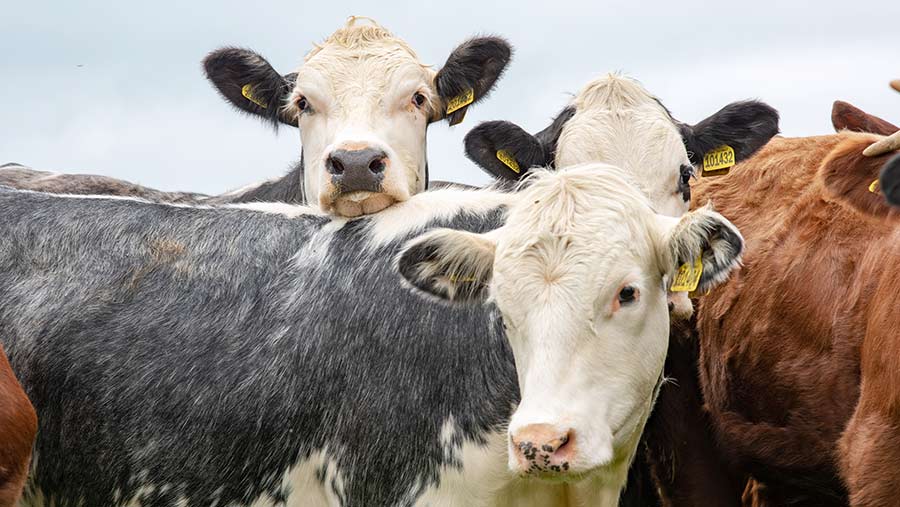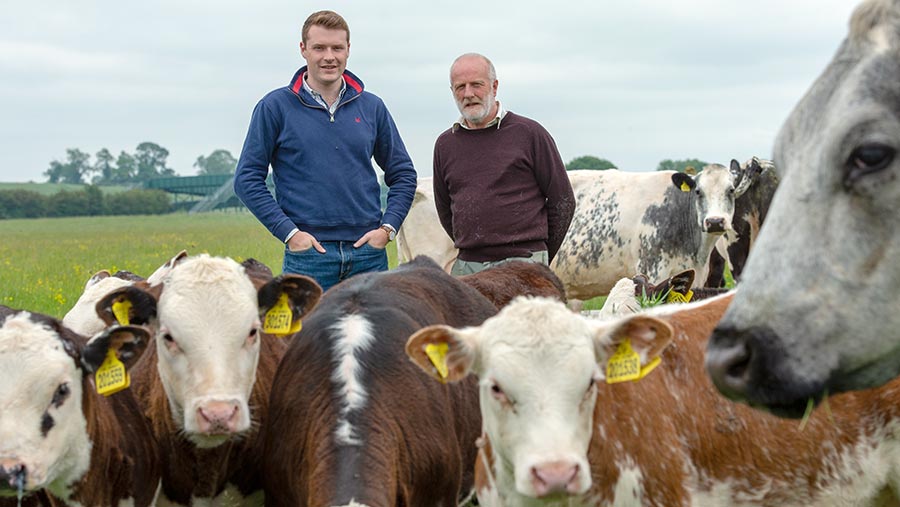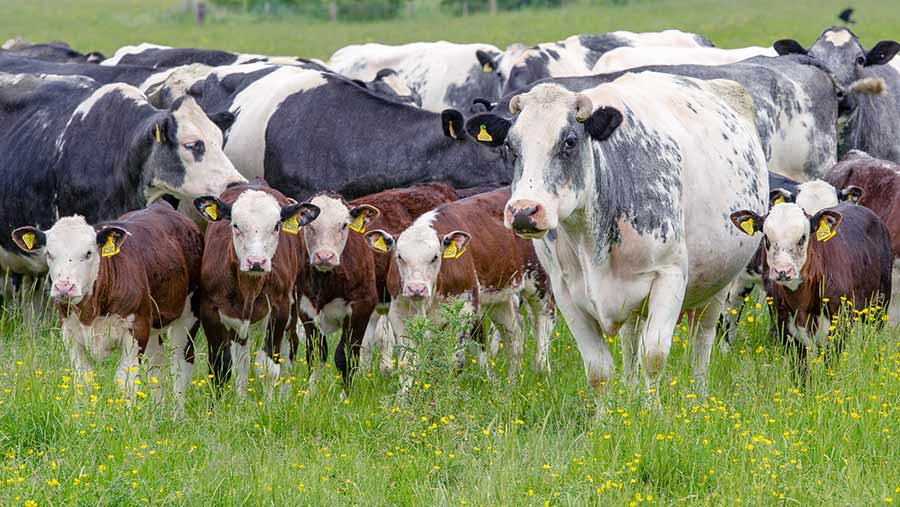Trial shows huge merit of using EBVs with beef herds

Using bulls with a higher terminal index can be worth more than £80 a finished calf, according to new research carried out at Harper Adams University.
Using Hereford bulls, the study aimed to compare the performance of progeny from top 35% and top 60% terminal index sires with calves finished at 19-22 months on a semi-intensive system.
Results showed that cattle born from a bull with a terminal sire index (TSI) of +27 (top 35% of the breed) significantly outperformed calves from a bull with a TSI of +23 (top 60% of breed).
See also: Current UK TB rules – and what’s coming next
The calves born to the higher TSI bull grew faster and finished 31 days quicker, reducing feed costs, and produced 7.5kg heavier carcasses.
Led by Matthew Rollason, a previous BSc Agriculture student who now works for Dunbia, alongside principal lecturer and beef specialist Simon Marsh, the trial took place at Sandy Hill Farm, Northamptonshire, where Mark Spendlove runs a commercial spring-calving suckler herd.

Matt Rollason (left) and Mark Spendlove at Sandy Hill Farm
“The economic difference was the most stark finding,” Mr Rollason said. “I didn’t anticipate how significant the difference would be. I was expecting a far more modest outcome.
“If you applied that cost difference to a larger-scale beef finishing unit, the amount would be greater still.”
He also highlighted that the study focused on feed savings and carcass gains, but there would be other fixed and variable cost benefits such as reduced bedding, shed space and labour.
Mr Spendlove said the results confirmed his previous thoughts that EBVs were crucial when selecting bulls.
“We would only buy bulls with figures provided. At the bull sales we spend more time looking at charts of EBVs rather than watching the ring,” he said.
“We’re selling meat, we’re not selling looks.”
Retail meat yield is a key value he looks at when selecting bulls (see “Bull selection at Sandy Hill Farm” box, below) and this trial has confirmed to Mr Spendlove that the modern Hereford is the right breed for him, to produce a carcass that the meat trade wants.
“The fact that we’re getting cattle of this breed to weight and specification and finished earlier and cheaper than continental breeds is encouraging and says quite a lot for the Hereford breed,” he said.
Bull selection at Sandy Hill Farm
Mr Spendlove bases his Hereford bull buying on a range of key factors:
Visual factors:
- Length is key because this is where the highest value meat is
- Width is considered, but in balance with calving ease
EBVs:
- Retail meat yield
- Eye muscle area
- Calving ease
The animals in the study
The suckler herd at Hill Farm comprises 125 British Blue x Holstein-Friesian suckler cows, producing 120 finished cattle annually on a semi-intensive system.
Approximately 20 British Blue x Holstein-Friesian replacement heifer calves, bought each autumn and bucket reared for 12 weeks, are bred to Hereford bulls at 15 months, aiming to calve at 24 months old.
Calves from the herd that were born to two different bulls in the spring of 2014 and 2015 were analysed when finished at 19-22 months of age in 2016 and 2017.
The two bulls used in the study:
- Bull A (Terminal Sire Index +27 – Top 35%) – selected on EBVs alone, not visually assessed before purchase.
- Bull B (Terminal Sire Index +23 – Top 60%) – a bull with successful show record, selected on phenotypic assessment alone.
How the bulls’ EBVs compare |
||||
|
|
Sire A (top 25%) |
Sire B (top 60%) |
||
|
EBV trait |
EBV value |
Percentile band |
EBV value |
Percentile band |
|
Terminal sire index |
+27 |
Top 35% |
+23 |
Top 60% |
|
Birth weight (kg) |
+3.8 |
Top 85% |
+1.2 |
Top 15% |
|
200 Day Wt (kg) |
+34 |
Top 15% |
+24 |
Top 65% |
|
400 Day Wt (kg) |
+65 |
Top 10% |
+48 |
Top 55% |
|
600 Day Wt (kg) |
+83 |
Top 10% |
+57 |
Top 60% |
|
Eye muscle area (sq cm) |
+3.7 |
Top 5% |
+2.0 |
Top 45% |
|
Rib fat (mm) |
+2.0 |
Top 99% |
+0.1 |
Top 70% |
|
Retail beef yield (%) |
-0.8 |
Top 99% |
+0.2 |
Top 65% |
The results
Results, across both heifers and steers from the two bulls, showed that:
- Bull A’s calves were slaughtered 31 days earlier at 616 days, rather than 647 days.
- Bull A produced carcasses 7.5kg heavier at 342.5kg.
- Bull A’s progeny gained weight faster at 0.56kg/day daily carcass gain, compared with 0.52kg/day.
- There was little difference in carcass grading, with the average conformation classification for all calves R- and the average fat classification for all calves 4-/4=.
- At the same carcass price of £3.82 (taken from a base price of £3.90/kg and including penalties for under- and overweights), Bull A’s calves saw an average carcass value of £1,308.35, while Bull B’s calves saw an average value of £1,279.
- Calving ease and percentage of calves reared were similar across both bulls.
Financial benefits
Both steers and heifers from Bull A finished earlier, saving on finishing costs.
Based on feed costs of £1.72/day for steers, getting steer calves finished 37 days earlier was worth £63.64/calf. With the heifers, at a feed cost of £1.61/day, getting them finished 25 days earlier was worth £40.25/calf.

Overall, the reduced feed costs and increased carcass weights of progeny from Bull A were worth £80.60 a calf. In a system like Mark Spendlove’s, producing 120 finished animals, this would equate to £9,672 (120 x £80.60).
Performance of steers and heifers from different terminal sires |
||||
|
|
Sire A (Top 35%) |
Sire B (Top 60%) |
||
|
Sex |
Steers |
Heifers |
Steers |
Heifers |
|
Age at slaughter (days) |
640 (21 mo) |
592 (19.4 mo) |
677 (22.2 mo) |
617 (20.2 mo) |
|
Carcass weight (kg) |
380 |
305 |
373 |
297 |
|
Daily carcass gain from birth (kg) |
0.59 |
0.52 |
0.55 |
0.48 |
|
Conformation classification (1-15) |
7.33 (R-/R=) |
6.49 (O=/R-) |
7.53 (R-/R=) |
6.50 (O+/R-) |
|
Fat classification (1-15) |
10.50 |
10.82 |
10.93 |
10.25 |
|
Carcass price (£/kg) – March 2018 |
3.82 |
3.82 |
3.78 |
3.84 |
|
Carcass value (£) |
1451.45 |
1166.35 |
1405.39 |
1139.31 |
|
EUROP carcass classification: Conformation P- =1 and E+ = 15, Fat: 1- = 1 and 5+ = 15. Carcass price standardised to a base price of £3.90/kg. Includes penalties for under and over weights. |
||||
